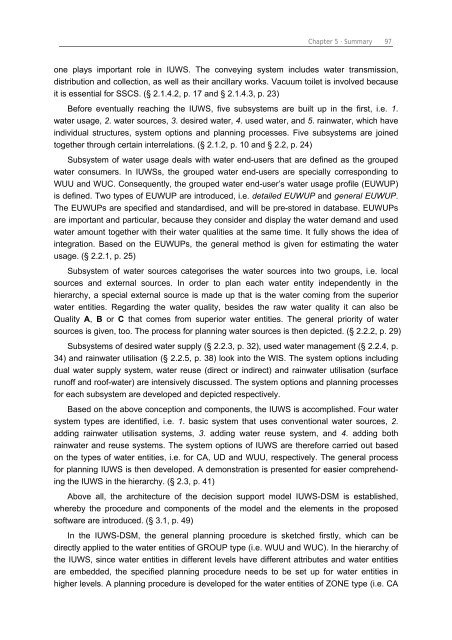Chapter 3 Decision Support Model (IUWS-DSM) - Tubdok
Chapter 3 Decision Support Model (IUWS-DSM) - Tubdok
Chapter 3 Decision Support Model (IUWS-DSM) - Tubdok
Create successful ePaper yourself
Turn your PDF publications into a flip-book with our unique Google optimized e-Paper software.
<strong>Chapter</strong> 5 · Summary 97<br />
one plays important role in <strong>IUWS</strong>. The conveying system includes water transmission,<br />
distribution and collection, as well as their ancillary works. Vacuum toilet is involved because<br />
it is essential for SSCS. (§ 2.1.4.2, p. 17 and § 2.1.4.3, p. 23)<br />
Before eventually reaching the <strong>IUWS</strong>, five subsystems are built up in the first, i.e. 1.<br />
water usage, 2. water sources, 3. desired water, 4. used water, and 5. rainwater, which have<br />
individual structures, system options and planning processes. Five subsystems are joined<br />
together through certain interrelations. (§ 2.1.2, p. 10 and § 2.2, p. 24)<br />
Subsystem of water usage deals with water end-users that are defined as the grouped<br />
water consumers. In <strong>IUWS</strong>s, the grouped water end-users are specially corresponding to<br />
WUU and WUC. Consequently, the grouped water end-user’s water usage profile (EUWUP)<br />
is defined. Two types of EUWUP are introduced, i.e. detailed EUWUP and general EUWUP.<br />
The EUWUPs are specified and standardised, and will be pre-stored in database. EUWUPs<br />
are important and particular, because they consider and display the water demand and used<br />
water amount together with their water qualities at the same time. It fully shows the idea of<br />
integration. Based on the EUWUPs, the general method is given for estimating the water<br />
usage. (§ 2.2.1, p. 25)<br />
Subsystem of water sources categorises the water sources into two groups, i.e. local<br />
sources and external sources. In order to plan each water entity independently in the<br />
hierarchy, a special external source is made up that is the water coming from the superior<br />
water entities. Regarding the water quality, besides the raw water quality it can also be<br />
Quality A, B or C that comes from superior water entities. The general priority of water<br />
sources is given, too. The process for planning water sources is then depicted. (§ 2.2.2, p. 29)<br />
Subsystems of desired water supply (§ 2.2.3, p. 32), used water management (§ 2.2.4, p.<br />
34) and rainwater utilisation (§ 2.2.5, p. 38) look into the WIS. The system options including<br />
dual water supply system, water reuse (direct or indirect) and rainwater utilisation (surface<br />
runoff and roof-water) are intensively discussed. The system options and planning processes<br />
for each subsystem are developed and depicted respectively.<br />
Based on the above conception and components, the <strong>IUWS</strong> is accomplished. Four water<br />
system types are identified, i.e. 1. basic system that uses conventional water sources, 2.<br />
adding rainwater utilisation systems, 3. adding water reuse system, and 4. adding both<br />
rainwater and reuse systems. The system options of <strong>IUWS</strong> are therefore carried out based<br />
on the types of water entities, i.e. for CA, UD and WUU, respectively. The general process<br />
for planning <strong>IUWS</strong> is then developed. A demonstration is presented for easier comprehending<br />
the <strong>IUWS</strong> in the hierarchy. (§ 2.3, p. 41)<br />
Above all, the architecture of the decision support model <strong>IUWS</strong>-<strong>DSM</strong> is established,<br />
whereby the procedure and components of the model and the elements in the proposed<br />
software are introduced. (§ 3.1, p. 49)<br />
In the <strong>IUWS</strong>-<strong>DSM</strong>, the general planning procedure is sketched firstly, which can be<br />
directly applied to the water entities of GROUP type (i.e. WUU and WUC). In the hierarchy of<br />
the <strong>IUWS</strong>, since water entities in different levels have different attributes and water entities<br />
are embedded, the specified planning procedure needs to be set up for water entities in<br />
higher levels. A planning procedure is developed for the water entities of ZONE type (i.e. CA

















